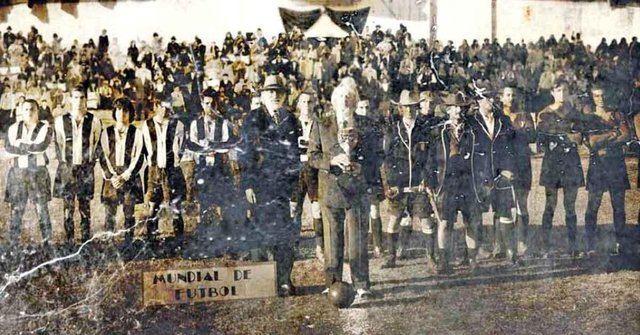Mystery World Cup in Patagonia

Documentation believed to be the opening moment of the World Cup in Patagonia 1942. Photo: Pressbook "Il Mundial Domenticato" Source
EUFORIA and the influence of football do not recognize the situation and conditions. Even as most of the world's terrain burned down in World War II, the round leather games remained rolling through the 1942 World Cup event in Latin America.
As the unofficial "World Cup" in Germany, this World Cup is also not recognized. Any soccer organization, especially FIFA, has never acknowledged it. "The 1942 World Cup was never mentioned in any history books, but was played in Patagonia, Argentina," said Osvaldo Soriano in Pensare con i Piedi.
The "World Cup" of Patagonia, which is now divided between Argentina and Chile - in 1942 still enters the power of King Antoine III of the Kingdom of Araucanía and Patagonia, took place in mid-November 1942. The tournament was initiated by the Balkan Royal Patagonia Minister of Religion, Count Vladimir von Otz. Participants were followed by 12 teams.
The teams that competed not only the Italian national team, Poland, Germany, Brazil, Scotland, England, the Soviet Union, Uruguay, Spain and France, but also local teams Real Patagonia and Mapuche. They are generally filled with players who are immigrants, miners, laborers, and Mapuche Indians.
The opening match was held November 8, 1942 by presenting the Italian counter Real Patagonia team. David Wood in Football and Literature in South America outlined, the 1942 Patagonia World Cup led to Mapuche Indian teams as champions after the final beat Germany 2-1.
Although many people are still questioning the truth of the tournament, the mystery of the World Cup began to emerge in 2011 when Italian filmmaker Lorenzo Garzella and Filippo Macelloni released a documentary entitled "Il Mundial Dimenticato" or "Missing World Cup". The 95-minute documentary featured senior Argentine journalist Sergio Levinsky's research, Garzella-Macelloni's findings, and interviews from figures from Jorge Valdano (former Argentine striker) to João Havelange (FIFA president 1974-1998).
The documentary also presents a Mapuche Indian named Sarkento who claims to be part of the Mapuche team. "Among the players on the team (Mapuche), I am the youngest. That's why I am now (2011) alive, "Sarkento said in the documentary.
From a number of Garzella-Macelloni's findings featured documentaries, there is a photo of the opening ceremony featuring Van Otz standing between the two teams holding the Jules Rimet trophy. Van Otz was the one who commissioned Guillermo Sandrini, an Argentinean Argentine cameraman, documenting the "World Cup" of Patagonia. The Jules Rimet trophy in the photo is still a mystery whether it is original or just a replica.
Levinsky's search has not gotten there yet. Also with the recording archive records Guillermo Sandrini. The majority of people think the World Cup is a mystery mysteriously veiled or just a legend.
Public distrust is reinforced by some oddities in the documentary. One of them, there is a referee in the tournament that is the son of Butch Cassidy, the runaway bandits from the United States. He is said to referee the game not with a whistle, but with a gun.
As a result, many people think the documentary tends to be a false documentary Mockumentary alias. Other opinions, including those interviewed by the documentary, consider Patagonia's "World Cup" a mere legend.
"Even if (1942's Patagonia World Cup) is just a legend, it remains important for football," Havelange said in the documentary before the 2016 cap.